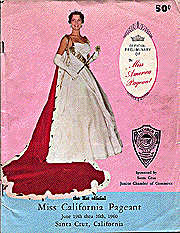
1960 Miss California Pageant Program
Doing research on the Miss America pageant for the Vonda Kay Van Dyke article in Mystery Date #4 really got me all hopped on Miss A, so when my husband pointed out a copy of the 1960 Miss California Pageant program at an antique store in Santa Cruz, California, well, I had to have it. While I spent more for it than I would have liked (oh, a little more than a new CD but less than the leather jacket I just got at Goodwill), it's been well worth it.
Of course, there's that wonderful cover, which you see reproduced at left, featuring Miss America 1960, Lynda Mead. (I should point out that while this was the competition to decide Miss California 1960, the pageant itself was a preliminary for the title of Miss America 1961.) What looks like a badge is actually the crest of the U.S. Junior Chamber of Commerce. The Jaycees, as they're also known, were the major sponsor of this pageant (and remain so for most state-level Miss America preliminary events today). Each contestant had her own local sponsor, generally her home town Chamber of Commerce. This led to some terrific prose, as each contestant had her own program page, with a photo, short bio, as well as some words from her sponsor.
So, for example, Miss Imperial Valley, Judy Storey, not only had to compete against the sex kitten-y Miss Los Angeles, Shyanne Tinsley, but also against her local Chamber of Commerce's Babbitt-like jingoism:
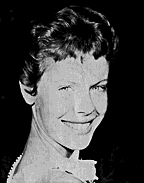
HOLTVILLE - CARROT CAPITOL OF THE WORLD. Center of the 7 million dollar Carrot Industry, home of the 4 day sun-filled, fun-packed Carrot Carnival, Holtville offers a wide variety of sights and activities in a delightful atmosphere of friendliness and leisure living . . .
This might seem innocuous at first, but remember that the title Miss Storey was competing for was Miss America, not Carrot Princess. Nevertheless, I'm sure the boys back at the Holtville Chamber day-dreamed about a newly-crowned Miss A telling reporters that she came from the Carrot Capitol of the World.
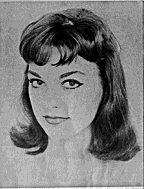
(That's Miss Imperial Valley, above, while Miss Los Angeles is at right.)
Of course, talent played a large role in the selection of Miss California, and the program listed each contestant's specialty. None of the acts came close to the trail blazed by Miss Montana 1949, who during the national pageant that year rode her horse on to, then off of the stage and into the audience in an exhibition of horsemanship skills gone horribly awry. Nonetheless, in addition to the usual singing and dancing, the judges in Santa Cruz were treated to dramatic readings (from The Diary of Anne Frank, and Thornton Wilder's Our Town), as well as my personal favorite, a "Baton Ballet," by none other than that firebrand from Imperial Valley.
In a perfect world, such talents would have granted Judy Storey the winner's tiara. Alas, whoever owned this program didn't record who took home the trophy and $1000 scholarship, as well as a plethora of prizes, from the sublime (two roundtrip all expenses paid tickets to Mexico City donated by the pageant committee) to the silly (a set of hoopskirts from Jean Tobriner -- most likely a specialty shop). In fact, the list of goodies awarded to Miss California herself down through Miss Congeniality takes up two full program pages. I'm sure the Fourth Runner-Up enjoyed her five pound box of candy from McFarland's on her long ride back to obscurity. (By the way, Nancy Fleming from Montague, Michigan went on to become Miss America 1961.)
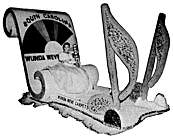
The program's final pages contain photo sections devoted to former Miss Americas, as well as the "Reigning Queens," in other words, all the contestants who didn't win the 1960 national title. But what I find really intriguing is the spread featuring the "Miss America Pageant Parade." Take a look at Miss South Carolina atop the "Wunda Weve Carpets" float to the left. I think the S.C. Jaycees were a little goofy on pheromones by the time they designed this one. Those are two large musical notes at the front corners of the float, and she's seated on some sort of scroll. This might be construed as a tribute to Miss S.C.'s musical ability, except there appears to be a rainbow of Wunda Weve carpet colors (I really should have typed "karpet kolors") framing her throne.
In fact, this float is key to understanding the Miss America mindset, past, present and future. Imagine a fluffy, pink-hued intersection of shameless commerce and raw sex, wherein the existence of each component is flatly denied by all involved. It's not a "beauty contest," heavens no, it's a "scholarship pageant." And make no mistake, the majority of Miss America's duties for the year of her reign will be to appear where and when the pageant's corporate sponsors want her. This is one reason why, with few exceptions, Miss America's public persona could charitably called "bland" -- god forbid she rock the boat. (And how Vanessa Williams must be enjoying the last laugh!) The official Miss America web site offers a look at the current crop of contestants, all of whom toe the pageant line, at least in their web page blurbs.
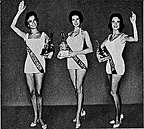
If you're interested in reading more about the Miss America Pageant, I can suggest no finer source than There She Is: The Life and Times of Miss America (New York: Penguin Books, 1978), Frank Deford's detailed and frequently hilarious history of the contest. I believe it's currently out of print, but what better reason for you to get up, turn off your computer, and go to the library?
